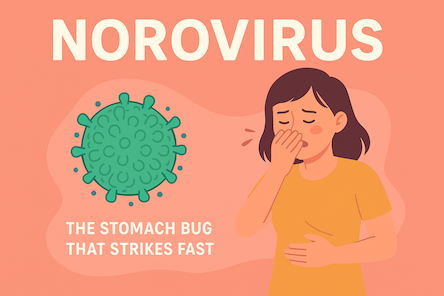Stay updated on what is trending in health. Discover tips and resources for a healthier, balanced life.
Norovirus: The Stomach Bug That Strikes Fast
Learn about norovirus—its symptoms, causes, prevention, and treatment. Stay protected from the “winter vomiting bug” with expert tips for recovery and care.
DISEASES AND CONDITIONS
Dr. S. Ali
10/2/20255 min read


If you’ve ever had a sudden bout of vomiting and diarrhea that seemed to come out of nowhere, chances are you’ve crossed paths with norovirus. Sometimes called the “winter vomiting bug,” this tiny but mighty virus spreads quickly and can make you feel miserable for a few days. The good news? It usually goes away on its own, and there are simple ways to prevent catching it (or passing it along).
In this guide, we’ll dive deep into everything you need to know about norovirus: what it is, how it spreads, symptoms, treatment, prevention, and even what to eat while recovering. Let’s break it down.
What Exactly Is Norovirus?
Norovirus is a very contagious virus that causes acute gastroenteritis — which is just a medical term for inflammation of your stomach and intestines. This leads to sudden symptoms like nausea, vomiting, diarrhea, and stomach pain.
It’s not a bacterial infection (like food poisoning from salmonella) and it’s not the flu (despite sometimes being called the “stomach flu”). Norovirus is in a league of its own, and it spreads like wildfire.
According to the CDC, norovirus is the leading cause of vomiting and diarrhea worldwide, responsible for hundreds of millions of cases every year. While it can affect anyone, young children, older adults, and people with weakened immune systems tend to get sicker.
How Do You Catch Norovirus?
Here’s the tricky part: norovirus is incredibly contagious. You only need a few virus particles to get sick, and they can survive on surfaces for days. You can catch it by:
Eating or drinking contaminated food or water – Raw shellfish, fresh produce, or food handled by someone sick can carry the virus.
Touching contaminated surfaces – Doorknobs, counters, and handrails can harbor the virus.
Close contact with an infected person – Caring for a sick child or partner often leads to infection.
Being in crowded spaces – Cruise ships, schools, daycare centers, and nursing homes are infamous for outbreaks.
Once the virus is inside you, it usually takes 12 to 48 hours for symptoms to appear.
Symptoms of Norovirus
Norovirus symptoms tend to come on suddenly and can be very intense, though the illness itself usually lasts 1 to 3 days. Common signs include:
Nausea – You may feel queasy before vomiting starts.
Vomiting – This is often forceful and frequent, especially in kids.
Diarrhea – Watery and sometimes explosive.
Stomach pain or cramps – Your gut feels tight or achy.
Fever – Usually low-grade (around 100°F / 38°C).
Headache and body aches – General “wiped-out” feeling.
Dehydration – Dry mouth, dizziness, dark urine, and fatigue.
When to Call a Doctor
Most people recover at home, but medical help is needed if you notice:
Signs of severe dehydration (very little urination, extreme thirst, dizziness).
Blood in stool or vomit.
Persistent vomiting that prevents you from keeping fluids down.
Very young children, elderly, or immunocompromised patients get sick.
Norovirus vs. Food Poisoning vs. Flu
It’s easy to confuse norovirus with other illnesses, but here’s how you can tell them apart:
Norovirus – Sudden vomiting and diarrhea, short-lived (1–3 days).
Food poisoning – Similar, but usually tied to a specific meal and may involve bacteria like salmonella or E. coli.
Flu (influenza) – Primarily respiratory (cough, sore throat, fever) — not a stomach illness.
How Is Norovirus Diagnosed?
In most cases, doctors don’t run tests because norovirus goes away quickly. But if symptoms are severe or prolonged, stool tests can confirm the virus. Outbreak investigations (like in cruise ships or nursing homes) often rely on lab confirmation to track the spread.
Treatment: What You Can Do at Home
Here’s the reality: there is no cure for norovirus. Antibiotics don’t work because it’s a virus, not bacteria. Treatment is all about managing symptoms and preventing dehydration.
1. Rehydrate, Rehydrate, Rehydrate
Drink plenty of fluids: water, diluted juice, or clear broths.
Oral rehydration solutions (like Pedialyte) are especially good for kids and older adults.
Small, frequent sips work better than chugging.
2. Rest Your Body
Stay in bed, and don’t push yourself. Your immune system needs energy to fight.
3. Adjust Your Diet
Start with the BRAT diet (bananas, rice, applesauce, toast).
Gradually add plain potatoes, crackers, or boiled chicken.
Avoid fatty, spicy, or dairy-heavy foods until you’re fully better.
4. Medications
Over-the-counter anti-diarrheal meds (like loperamide or Imodium) should only be used sparingly and not for children without a doctor’s advice.
Pain relievers like acetaminophen can help with fever and aches.
Can You Prevent Norovirus?
Yes — but it takes effort, because this virus is stubborn. Here’s how to lower your risk:
Wash hands thoroughly with soap and water (hand sanitizer doesn’t work well against norovirus).
Disinfect surfaces with bleach-based cleaners, especially bathrooms and kitchens.
Wash laundry (like soiled clothes and sheets) in hot water.
Rinse produce well and cook shellfish thoroughly.
Stay home when you’re sick and for at least 48 hours after symptoms stop.
Norovirus Complications
While most healthy people bounce back, complications can occur, especially in vulnerable groups:
Severe dehydration – Leading cause of hospitalization.
Electrolyte imbalance – Dangerous shifts in sodium and potassium.
Malnutrition – In prolonged illness, especially in children.
Norovirus in Children
Kids often get hit hard because they dehydrate quickly. Watch for signs like:
Dry diapers for more than 6 hours.
Sunken eyes or no tears when crying.
Irritability or unusual sleepiness.
Oral rehydration solutions are key. If your child refuses to drink or shows severe symptoms, seek medical care immediately.
Norovirus in Adults and Seniors
Older adults may have a harder time recovering, especially if they have other health conditions. Nursing homes often deal with outbreaks that spread rapidly due to close living quarters and shared facilities.
How Long Are You Contagious?
This is important: you’re most contagious when you’re sick and during the first few days after recovery. But studies show the virus can still be shed in stool for up to two weeks! That’s why hygiene and careful cleaning are so important.
Norovirus Outbreaks Around the World
Cruise ships – Confined spaces make it easy for the virus to spread.
Schools and daycares – Kids are less careful about hygiene.
Hospitals and nursing homes – Vulnerable patients are at higher risk.
Restaurants and catering events – Food handled by someone sick can trigger mass outbreaks.
FAQs About Norovirus
1. Is norovirus deadly?
Most people recover, but it can be dangerous for infants, elderly, or those with weak immune systems if dehydration sets in.
2. How do I know if I have norovirus or food poisoning?
Both cause vomiting and diarrhea, but norovirus spreads person-to-person, while food poisoning usually comes from one contaminated meal.
3. Can you get norovirus twice?
Yes! Immunity is short-lived, and there are many strains.
4. Does norovirus only happen in winter?
No, you can catch it year-round, though outbreaks are more common in colder months.
Key Takeaway
Norovirus is fast, furious, and extremely contagious — but also short-lived. With good hydration, rest, and hygiene, most people bounce back quickly. The real danger lies in dehydration, so keeping fluids in is the top priority.
The best prevention? Wash your hands with soap and water, keep your distance from anyone sick, and disinfect surfaces regularly.
Related Articles:
1. Gastroenteritis: The Stomach Flu You Don't Want
2. Imodium (Loperamide): What It Is, How It Works, and When to Use It
3. What is Haemophilus influenzae? A Simple Guide to Understanding This Bacteria
Sources:
1. Centers for Disease Control and Prevention (CDC) – Norovirus
https://www.cdc.gov/norovirus/index.html
2. World Health Organization (WHO) – Norovirus
https://www.who.int/news-room/fact-sheets/detail/diarrhoeal-disease
3. Mayo Clinic – Norovirus infection
https://www.mayoclinic.org/diseases-conditions/norovirus/symptoms-causes/syc-20355296
4. NHS (UK) – Norovirus (vomiting bug)
https://www.nhs.uk/conditions/norovirus/
5. Johns Hopkins Medicine – Norovirus
https://www.hopkinsmedicine.org/health/conditions-and-diseases/norovirus
6. Food and Drug Administration (FDA) – Norovirus and Food Safety
https://www.fda.gov/food/risk-and-safety-assessments-food/risk-assessment-norovirus-transmission-food-establishments
7. Cleveland Clinic – Norovirus Infection
https://my.clevelandclinic.org/health/diseases/17703-norovirus
Pulse Your Health
Empowering you to achieve your health goals.
Contact
© 2025. All rights reserved.
Disclaimer: The content on this website is for informational purposes only and is not medical advice. Always seek the advice of your physician or other suitably qualified healthcare professional for diagnosis, treatment and your health related needs.
